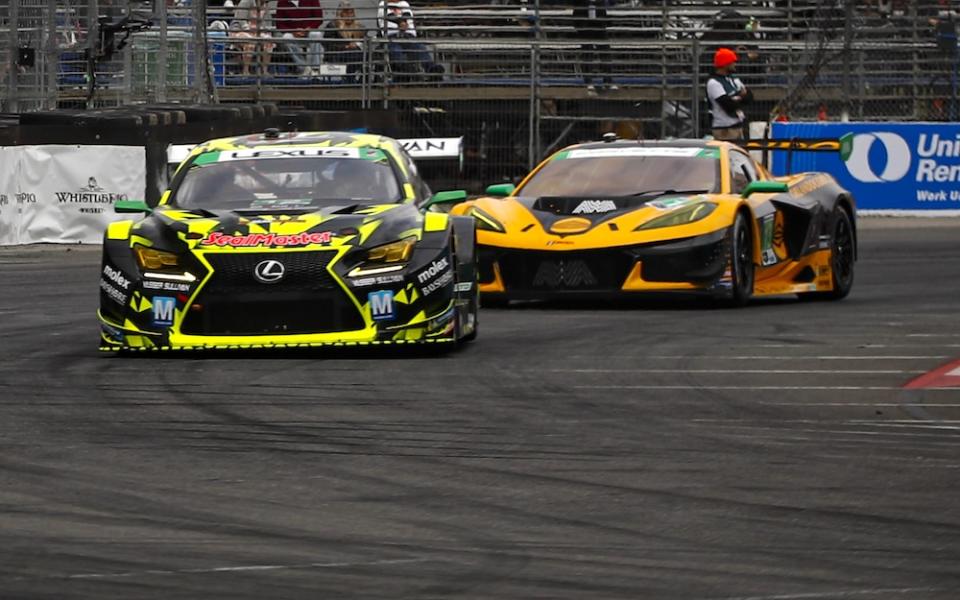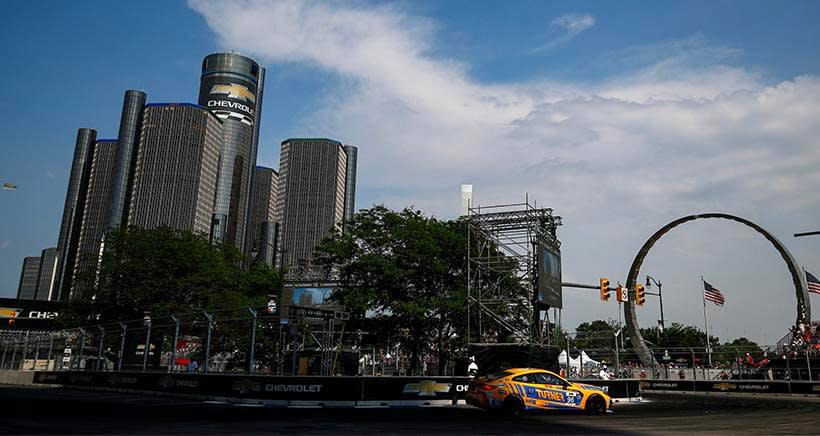Hawksworth and Milner rely on sim time to prep for new Detroit circuit

The first time Jack Hawksworth encountered the streets of downtown Detroit on a racing simulator, he resisted the urge to go as fast as possible.
“I tried to treat it like the real thing,” Hawksworth said. “Obviously, if you go out there and start clipping walls and just sending it, it doesn’t put you into the right mindset heading into a street course weekend. You try to be somewhat disciplined because when you’re in the real car you have to be disciplined.”
As IMSA WeatherTech SportsCar Championship teams and drivers prepare for the series’ first visit to the street circuit for Saturday’s Chevrolet Detroit Sports Car Classic, simulators have served an essential role in preparation, especially for teams and drivers in the GTD PRO class.
Hawksworth and Tommy Milner know the simulator drill well, but only recently experienced the Detroit circuit on a simulator. Hawksworth, who co-drives the No. 14 Vasser Sullivan Lexus RC F GT3 with Ben Barnicoat, did his test at a Toyota Racing Development facility in Salisbury, N.C. Milner, who teams with Nicky Catsburg in the No. 4 Corvette Racing by Pratt Miller Motorsports Chevrolet Corvette Z06 GT3.R, did a full day on the Detroit course in a simulator at a Pratt Miller facility in Huntersville, N.C.
As tempting as it was, Hawksworth and Milner didn’t push the limits during their first sim runs on the Detroit course. Instead, they followed protocol with their engineers, learning both the course and their cars’ capabilities in a step-by-step procedure.
“If we’re messing around too much and crashing the car and not taking it seriously, we’re not helping with the plan for the day,” Milner said. “The atmosphere and the structure of it all still makes it feel like an important and worthwhile event.”
The annual Detroit street race isn’t new to the WeatherTech Championship — the series raced at the old Belle Isle circuit 12 times between 2007 and 2022 — but the latest track configuration is new to the series.
In 2023, the event moved four miles from Belle Isle to a downtown street circuit near the Detroit River but the WeatherTech Championship wasn’t on the schedule. Instead, the IMSA Michelin Pilot Challenge christened the downtown course. Two WeatherTech Championship classes — GTP and GTD PRO — will compete Friday and Saturday for the first time on the nine-turn, 1.654-mile circuit.
For those who’ve tested the new layout on simulators, one thing stands out: It’s tight.
“It’s very, very tight — extremely tight,” Hawksworth said. “It’s probably the tightest circuit we’ve ever gone to. A lot of the corners are first gear. There are no high-speed corners; it’s all really low speed, and it’s narrower than anywhere else we race. … It’s probably more similar to Long Beach than the old Belle Isle track.”
The circuit is straightforward and typical of downtown street circuits. It features six left-hand turns and three right-handers, all relatively low-speed and narrow. Of particular concern is Turn 3, a hairpin at the end of a long straightaway that requires hard braking into a tight left-hander.
“For whatever reason, on the sim you feel like you have a little more room than you do once you’re there in real life,” Milner said. “The walls feel a little bit closer, especially for a street track. The penalty for failure is pretty obvious once you see it in real life.”
Professional racing simulators are far from their video game counterparts: Drivers sit in a large pod resembling a race car’s cockpit, with a video screen coupled to machinery that uses computer software to manipulate the cockpit in precise motions that replicate the car’s motion on the track.
They’re quite realistic, drivers say. Milner noted the Detroit software showed signage identical to last year’s race, providing visual cues and marks for drivers. As realistic as they are, though, simulators aren’t quite the same as the real thing.
“It’s getting closer all the time,” Hawksworth said. “Sometimes, we find it very useful. Other times, it’s not quite as useful. It’s a constant exercise where you’re basically trying to get the thing closer and closer (to reality). Sometimes we get it really close to feeling like it’s the real thing, and other times it doesn’t feel quite as realistic. It’s a moving target.”
From an engineering standpoint, however, simulators are highly effective. Fuel and tire management, as well as car setup and race strategy, are mapped out with the aid of data acquired from simulators.
“The sim tests are structured very similar to how we would structure any test or practice session,” Milner said. “The engineers have a plan for setup, changes they would like to try. The first part of the test was just a familiarization phase for me, and then we ran through a couple of changes to see how the car reacts to the changes.”
In planning for a yet-to-be-raced circuit, simulators are essential for drivers. Every turn experienced, every bump felt, every mistake forgiven.
“When we go to a new track like Detroit, it’s more useful for drivers,” Hawksworth said. “Just to get laps and to get a look at the circuit and get into a rhythm going around that place.”
Live coverage of the 100-minute race begins Saturday at 3pm ET on USA Network, Peacock and IMSA Radio.

 Yahoo Autos
Yahoo Autos 
